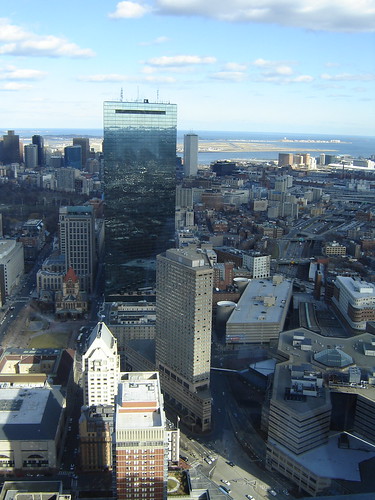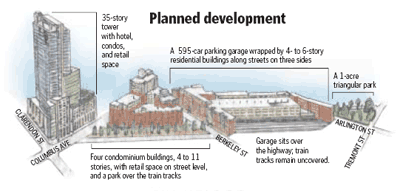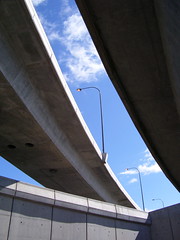The Popular Front for the Removal of Urban Highways and the Banishment of Unsightly Street Level Parking (or PFRUHBUSLP, for short)
Back in the good old days of the Black Plague, Leonardo (da Vinci, not ninja turtle) sat down and addressed the problem building a new city to replace Milan. The assumption was that the overcrowding in the city was the root cause of the spread of the plague, and to some extent that was true. Leonardo, as usual, was a genius. His plan managed to hit some of the major points of city planning that wouldn't emerge as important until hundreds of years later. For example, drinking water and sewage didn't come from and go to the same places! Genius, huh? But here is the part I really like. Leonardo's city had two levels, an upper one for pedestrians and a lower one for "wheeled vehicles." It would seem that Leo predicted the Big Dig hundreds of years before the car existed.
Now if I had to choose the two things that I dislike the most about American cities, it would be the prevalence of urban highways and the abundance of street level parking (I don't mean on-street parking, which is fine, but rather entire blocks with nothing on them but cars). In Minneapolis a few weeks ago, I was on the east side of downtown and noticed that there were no buildings at all for four blocks in front of me, just parking.
I'm not unrealistic, I know we need parking in our downtowns. It should just be better hidden. Luckily, the increasing land values in downtowns seem to be helping with this problem (except in the vicinity of sports stadiums, where city governments really need to step in and zone aggressively to get rid of them).
With regards to highways, I think we are becoming more and more aware of their detrimental effects on urban areas. The Congress for the New Urbanism, which is meeting this June in Providence, is focusing part of their meeting on the problem and numerous cities (Boston, Providence, Milwaukee, Portland, New York, San Francisco, Chattanooga) are moving forward with plans to either bury or remove urban highways all together. We seem to be moving towards a time when having Highways in the city will be about as acceptable as slaughterhouses and oil refineries.
Here in Boston, we've obviously got the huge public works project called the Big Dig, but what many people have overlooked is that the city has also opened highway covering up to private investors. 20 something years ago, the Prudential Center covered over a good portion of the Mass Turnpike between the Back Bay and South End neighborhoods. At the time, the assumption was that other companies would cover other sections until the Back Bay and South End were completely reconnected and there would be a new "spine" of tall buildings running from Downtown towards the Fenway. As you can see from this picture, which was taken from the Prudential, the Hancock building and a handful of other buildings have given this area some significant height (downtown is in the distance, the uncovered part of the Mass Pike on the right), but up until now, no one else has taken on the challenge of covering anymore of the highway.

Well, ground was finally broken last week for the next part of this project, Columbus Center, which will effectively reconnect the Back Bay and the South End. Columbus Center has a 35 story tower, drawing a line of sight from downtowns office towers to the tall buildings of the Back Bay, as well as several smaller condo/retail buildings which will fit in well with the South End's residential and architectural character.

Kudos guys. Keep the good stuff coming.
Now if I had to choose the two things that I dislike the most about American cities, it would be the prevalence of urban highways and the abundance of street level parking (I don't mean on-street parking, which is fine, but rather entire blocks with nothing on them but cars). In Minneapolis a few weeks ago, I was on the east side of downtown and noticed that there were no buildings at all for four blocks in front of me, just parking.
I'm not unrealistic, I know we need parking in our downtowns. It should just be better hidden. Luckily, the increasing land values in downtowns seem to be helping with this problem (except in the vicinity of sports stadiums, where city governments really need to step in and zone aggressively to get rid of them).
With regards to highways, I think we are becoming more and more aware of their detrimental effects on urban areas. The Congress for the New Urbanism, which is meeting this June in Providence, is focusing part of their meeting on the problem and numerous cities (Boston, Providence, Milwaukee, Portland, New York, San Francisco, Chattanooga) are moving forward with plans to either bury or remove urban highways all together. We seem to be moving towards a time when having Highways in the city will be about as acceptable as slaughterhouses and oil refineries.
Here in Boston, we've obviously got the huge public works project called the Big Dig, but what many people have overlooked is that the city has also opened highway covering up to private investors. 20 something years ago, the Prudential Center covered over a good portion of the Mass Turnpike between the Back Bay and South End neighborhoods. At the time, the assumption was that other companies would cover other sections until the Back Bay and South End were completely reconnected and there would be a new "spine" of tall buildings running from Downtown towards the Fenway. As you can see from this picture, which was taken from the Prudential, the Hancock building and a handful of other buildings have given this area some significant height (downtown is in the distance, the uncovered part of the Mass Pike on the right), but up until now, no one else has taken on the challenge of covering anymore of the highway.

Well, ground was finally broken last week for the next part of this project, Columbus Center, which will effectively reconnect the Back Bay and the South End. Columbus Center has a 35 story tower, drawing a line of sight from downtowns office towers to the tall buildings of the Back Bay, as well as several smaller condo/retail buildings which will fit in well with the South End's residential and architectural character.

Kudos guys. Keep the good stuff coming.





3 comments:
Interesting. I can't wait to move back and see all that has been going on.
Parking lots can be a major pain the ass for many downtowns for so many reasons. Beyond the environmental costs (i.e. the groundwater drain off that happens when you have a big spat of concrete or blacktop) they're a little like roaches, they are almost impossible to get rid of once you get them.
For many reasons, surface lots don't quite respond quite as well to land prices as you hope or think. I believe this is for a couple reasons.
You've got a great income stream (cars) and no building on the site, which means there's some sort of strange disproportionate relationship between land value (essentially a measure of the amount of income one can expect from a site), the actual income, and taxes.
Values are artificially kept low on parking lot areas (since there's no building on them, and who knows what's below it) - except in the minds of the lot owners - who build the values up extraordinally high (land banking). With a constant income stream of parkers, it pays to keep the parking lot a parking lot. Unless you sell it to someone who's willing to pay enough. Then it pays even more.
If you check on my page I'll post one of the craziest photos I've ever seen of surface parking lots (Houston, TX).
It's from a book I think you'd enjoy: The City Assembled: The Elements of Urban Fom Throughout History, by Sprio Kostof
thanks for the recomendation. planetizen has some podcasts this week on the subject too.
Post a Comment